1950s Development
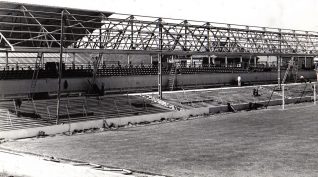

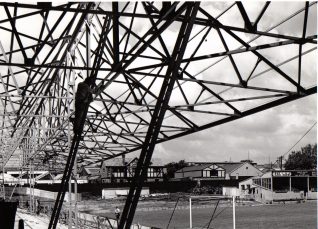
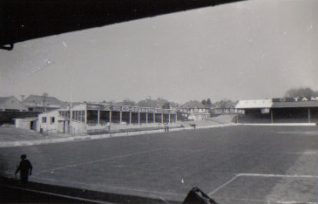
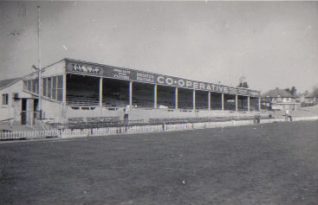
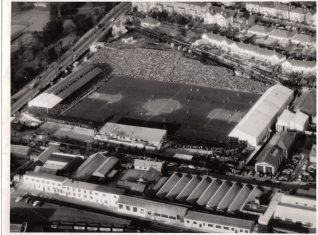
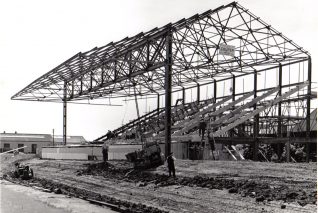
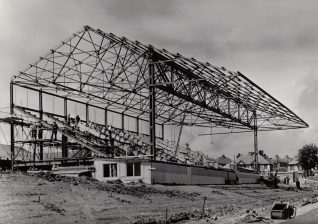
Old photographs
My father-in-law gave me the accompanying photographs, which have not seen the light of day for many years. Photographs of the early post-war Goldstone Ground seem to be few and far between, these are gems! Sadly my father-in-law passed away earlier this year but I’m sure he would have liked me to share the photos via this website.
Development dates
Although I can’t confirm the dates but looking at the History of the Goldstone Ground by John Hewitt on this website, they would appear to have been taken between 1954 and 1958.
New South Stand 1954
Images 1 – 3 show the steelwork of the new South Stand under construction in 1954. It seems that the foundations had been completed in 1949 but the stand was not built until 5 years later.
Image 3 is taken from the south looking west, the old West Stand can be seen in the bottom right corner.
Re-development planning
The complete redevelopment of the Goldstone Ground had been planned as post-war crowds reached record levels. This was to be carried out in stages over a 10 year period throughout the 1950s.
The Old West Stand
Images 4 and 5 are taken from the newly constructed South Stand looking northwest towards the old West Stand. The houses in the Old Shoreham Road can be clearly seen. Also what becomes apparent is the very small capacity and size of the old West Stand. The advertising of the Co-operative can also easily be seen on the facia of the stand. Another interesting point is that image 4 shows the extended roof of the North Stand, this work having been carried out 1956-57.
Re-development half complete
Image 6 is a fantastic aerial shot of the Goldstone Ground taken just prior to the redevelopment of the West Stand in 1958. Albion won the match by a 3 or 4 goal margin. My father-in-law told me the score and who the opponents were but unfortunately I can’t remember. The new South Stand has been completed and also the extended roof of the North Stand can be seen, however the old small West Stand is waiting for redevelopment. Interesting points to note are:
- No floodlighting in place
- Some housing in Goldstone Lane incomplete
- House just inside the very northeast corner of the ground. This was wasteland, but within the perimeter fence, when I watched the Albion in the late 60s and throughout the 70s. Burger King now occupies the spot.
- Industrial area in Newtown Road with nissan huts still in place. Zoom in and people can be seen standing on the flat roof of the building bottom left had corner.
- Coal/goods wagons in the foreground. This was the goods yard of Hove Station which was still there until the early 80s. Now the site of Focus Do-it-All.
- Little traffic in Old Shoreham Road
- Tamplins Ales advertising on the roof of the North Stand
- Surely a capacity crowd!
New West Stand 1958
Images 7 and 8 show the steel work of the new West Stand under construction in 1958. Image 7 is taken looking south and 8 is looking north. It almost looks as if the new stand was built partially on top of the old stand, the white timber building seen below the steel work.
Into the 1960s
Although other development plans for the Goldstone Ground went ahead, such as floodlighting, there was a further plan to develop a massive office block behind the West Stand to run the whole length of Newtown Road. This was a real grandiose plan, way ahead of its time. Unfortunately the full plan was not implemented and the staff had to make do with the smaller office and management facilities under the West Stand.




Comments about this page
Well done for putting these on. Although I have a UK email I am living in Australia now and was trying to date the 1957 photo on our fans forum. I am sure you will get more response as I have posted the page on the message board for everyone to see. A very interesting read of our history, well done again.
I have been in America now for 23 years (now in Denver) but I was born in Brighton, moved away, then back to Brighton when I left school to attend college. My first Brighton game was a 0-0 draw against Bristol City, I think on my 10th birthday treat with my friends. We sat in the South stand. My dad fell asleep. I moved back in 1978, I lived about 10 min walk from the ground off Sackville Road. I was a big Mark Lawrenson fan. I remember being on a bus travelling into town along the Old Shoreham Road listening to my radio when we beat Newcastle to get promotion – everyone was honking and flashing their lights. I loved Brighton, but always knew we would never win anything major – 1983 was the closest we came. Thanks for the site and the memories.
Seeing the aerial view reminds me of happy afternoons and evenings back in the 64-65 promotion season. Admission to the proletarian east terrace, back in those days of sport for all, not just the rich, was “three shillings for men, one shilling for boys” (women and girls presumably not encouraged). On one rainy Saturday I had just shouted a loud but fairly mild expletive at a laggardly defender, when I turned to find the headmaster of my school, Mr Harry Brogden, standing behind my shoulder. This made me quiver somewhat as he was a noted disciplinarian and a JP, but he appeared to take the incident in good humour as I heard nothing about it afterwards.
Peter, according to Tim Carder and Roger Harris’s book, “Seagulls”, demolition of the old West Stand began on 1 May 1958. On the previous day, by far the biggest Goldstone crowd of the 1957/58 season, 31,038, (a new league record) had seen the Albion clinch promotion to the old Division 2 with an amazing 6-0 victory over Watford. Local boy Adrian Thorne scored five of the goals, including a four-minute hat-trick in the first nine minutes of the game. The book explains that many of those fans who were unable to gain admittance to the ground itself lined the factory roofs in Newtown Road. This pin-points the date of your photo in Image 6 as 30 April 1958.
Yes Alan, I think you are correct, my father-in-law also told me about the photo being of an important high-scoring match, but I could not remember which one, and by then he had sadly passed away
Any idea what the capacity of the new West Stand was? And where did the away supporters usually congregate in pre-segregation days of the 1960s?
On the West Stand capacity, my guess would be around 8,000, but it’s only a guess. The pre-segregation went on into the 1970s, when no tickets were required, they could pretty much go in any standing area. I do remember Palace fans in the corner between the Chicken Run and North Stand. Back then, and even more so in the 60s, not so many travelled to away matches as today!
I started going to the Goldstone in the early 50s. It was possible then at half time to go from the North goal to the South goal, and we did it many times. I too went to the Grammar school but did not know that Harry Brogden was a supporter. One Saturday I had a major detention, where in the school house, I had to write an essay on Shakespeare. We had to go to school on Saturday mornings, and on this day he dismissed me with just enough time to get to the match. Adrian Thorne was at the school also and I remember him as being good at athletics, cricket and in football he was fantastic. It did not surprise me what he did on that day.
Does anyone have any recollection of a war tank being situated at the Goldstone in the early years?
Add a comment about this page